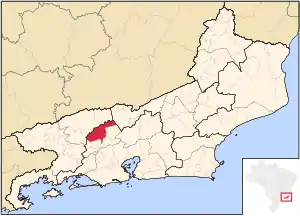Vassouras | |
|---|---|
| Municipality of Vassouras | |
.png.webp) Flag  Seal | |
| Motto: "Mihi maxime debetur Brasiliae incrementum" | |
 Location in Rio de Janeiro | |
| Coordinates: 22°24′14″S 43°39′46″W / 22.40389°S 43.66278°W | |
| Country | |
| Region | Southeast |
| State | |
| Founded | 15 January 1833 |
| Government | |
| • Mayor | Severino Ananias Dias Filho |
| Area | |
| • Total | 552.438 km2 (213.298 sq mi) |
| Elevation | 434 m (1,424 ft) |
| Population (2020)[1] | |
| • Total | 37,083 |
| • Density | 67/km2 (170/sq mi) |
| Time zone | UTC−3 (BRT) |
| HDI (2010) | 0.714 – high[2] |
| Website | vassouras |
Vassouras (Portuguese: [vɐˈsowɾɐs], lit. 'Brooms') is a municipality located in the Brazilian state of Rio de Janeiro. Its population was 37,083 (2020) and its area is 552 km².[3]
The town is known for its colonial-era coffee farms, with significant royal structures, and the current seat of the Brazilian imperial family.
Vassouras was the setting for the Bangu neighborhood portrayed in the 1970 Brazilian film My Sweet Orange Tree, as well as the fictional town of "Florença" depicted in the 2001 miniseries Presença de Anita.[4][5]
References
- ↑ IBGE 2020
- ↑ "Archived copy" (PDF). United Nations Development Programme (UNDP). Archived from the original (PDF) on July 8, 2014. Retrieved August 1, 2013.
{{cite web}}: CS1 maint: archived copy as title (link) - ↑ IBGE -
- ↑ "Dica da Folha - Folha Fluminense .: Jornalismo com Responsabilidade Social :". 2016-03-06. Archived from the original on 2016-03-06. Retrieved 2023-08-07.
- ↑ Xavier, Nilson. "Presença de Anita". Teledramaturgia (in Brazilian Portuguese). Retrieved 2023-08-07.
This article is issued from Wikipedia. The text is licensed under Creative Commons - Attribution - Sharealike. Additional terms may apply for the media files.







